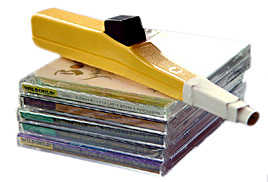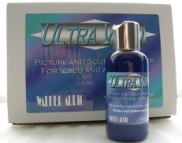
You are reading the older HTML site
Positive Feedback ISSUE
march/april 2007
walker audio
Talisman, Ultra-Vivid, and Prelude Record Cleaning System
as reviewed by Marshall Nack
|
Walker Tweaks Ahoy, Matey!
It's not the first time. I was talking to Lloyd Walker about his latest high-end tweak, the Talisman, a static electricity remover and magnetic field optimizing product for CDs and LPs.
"The Talisman will give you two jumps up on a scale of one to five," he exclaimed. "Now, if you combine it with my Ultra Vivid CD treatment, you get another leg up. The two tweaks work synergistically."
His enthusiasm was contagious, even though what ladder he was climbing was never made explicit. Next week's conversation picked up where the first left off.
"I have the formula 92% completed," Lloyd said. "Give me two weeks after the Rocky Mt. Audio Fest and it will be done. I've verified through rigorous testing, this is positively the ultimate wet wash for vinyl."
One thing led to another, proving the old adage, "If you're in for a nickel, you're in for a dime." Who can resist? "Send them over, Lloyd."

Real Sound: Zankel Hall
After catching Christophe Rousset and his period instrument ensemble Les Talons Lyrique at Zankel Hall, Carnegie Hall's new venue, I picked up a copy of the group's Six Concerts en Sextuor by Jean-Philippe Rameau (Decca B0001845-02). Three copies, to be exact: I figured I needed that many to cover the options I'd be testing. Disc number one would be untreated (the Control); number two would be washed with Ultra Vivid; and number three would be the only one to meet the Talisman.
The Control CD doesn't sound anything like what I heard at Zankel. Of course, it's live vs. reproduction, but we're talking polar differences in favor of the repro. Zankel is another case demonstrating that even the professional acousticians can't always do it right. Granted Zankel's sound is clear as a bell—every little cough and foot scrape, on stage and off, is plainly audible. The trouble is, it's clarity rendered to the nth degree. Sadly, this is achieved by zapping the hall's acoustic. Looking around, you'll spy wooden diffusors on practically every vertical surface. (And that's just what's visible. Who knows what devices lurk unseen?) These work as designed and cancel all of the natural support and enrichment normally provided by the venue. The undernourished result suppresses bloom, compresses dynamics, and keeps the sound trapped on the stage—it should come out, excite the room, and surround you. But how can it do that? Nothing in the room is allowed to resonate. The overzealous room treatment in this professionally designed showplace results in a focused, precious sound that is over-controlled and dull. Cancel my subscription, please. Why is it we can't construct good sounding halls these days? (BTW, you can facilitate this effect in the listening room with the expensive, but very effective, Resonators made by Acoustic System.)
The Talisman
Listening to the Control CD, the one without any treatment, instruments appear vague. Images suffer from "duck's disease" (skinny on top with increasing spread as you go lower), resulting in some timing discontinuity between the harpsichord and the rest of the continuo. The violins sound faster while the celli and double bass are too big and hang around too long. And the treble is grainy, compounding a whiny quality in the violins. (While this is not the best sounding CD, I still prefer it to what I heard in Zankel.)
After three passes of the Talisman ($199) on each side of CD three (this takes about six seconds and minimal effort), let's see what we've got. The differences are fairly large. Most noticeable is the dip in the treble; the mid and low frequencies are in the fore now, with a darker tonal balance.
The view is tighter and more controlled. Images have been concentrated into small, dense objects, with a better distribution of flesh from top to bottom. This positively impacted the timing discordance—bass and treble come and go in sync—which in turn affected reverb trails. They are about as long as before, but they don't occur where they're not expected. In general, I'm not hearing things I'm not supposed to hear, like graininess or a metallic hue. And the violins have stopped whining, thank goodness.
It also sounds quieter and softer. I need to turn up the volume to level match the control CD (probably a result of the reduced treble). The Talisman comes closer to what I heard at Zankel in terms of purity and focus, if darker, with more bloom and hall ambiance.
I like the shapelier notes of the Talisman. In addition to their roundness and deep tonal saturation, the images' explicit boundaries give me clues about pitch values and who's doing the playing. On the Control disc, I can't put my finger on the notes' terminations and it's more difficult to determine intervals. One fellow, an aspiring orchestral conductor, put it: "The Talisman disc sounds harsher, more gritty, but not in a bad way. You can hear the bow horsehairs scraping on the string. Normally, you don't hear this from an audience seat. It's a question of how close do you want to get to the violin." I think that's it in a nutshell. The Talisman is revealing more information by getting rid of extraneous stuff—it's not fabricating or coloring anything. But do you feel comfortable sitting that close?
Roughly half of my listening panel thought not. They enjoyed the loose grip and free-flowing dynamics of the Control disc; they found it more realistic. I admit there is charm in the untreated disc's limber, fluid line. It is more of a schmeer, holistic from top to bottom and left to right, and more forgiving. (Isn't this always the case—whenever you back off on resolution, you hide the blemishes and the schmeer seems more coherent. It's easy to get a certain level of good sound when you lower the resolution.)
Still, I wouldn't want to listen to the Control disc after hearing what the Talisman does.
The Talisman contains strong, uniquely oriented magnets set in epoxy, housed within a small aluminum holder. The manufacturer claims it "temporarily dissipates magnetic fields and static electricity." It is completely passive: there is no trigger, batteries or power cords and it never needs recharging. The effects are temporary and must be applied before every play. There is a warning in the instructions about keeping it away from components, phono cartridges, or any metal material. I generally followed this direction and didn't have any problems.

The Competition: the Ionoclast
I happen to own a competing product called The Ionoclast Static Neutralizer, by Mapleshade Audio. The $38.50 Ionoclast uses a piezo-ceramic spark generator to blast the CD with positive and negative ions, similar to the old-fashioned Zerostat (which now sells for $75 from Audio Advisor). You press a large button (or trigger) to send out a stream of positive ions, then release, emitting a barrage of offsetting negative ones. The Mapleshade catalog claims its effects are good for five to ten plays.
The Ionoclast has a lot in common with the Talisman. You get as much definition and even more explicit boundaries that are cut too sharply for my taste. While avoiding brittleness, both stage dimensions and image size have shrunk.
double 'em up
Alrighty, then. How about giving the Talisman disc a blast with the Ionoclast? (BTW, the Ionoclast takes longer to apply and requires more effort than the Talisman.) Doubling 'em up actually worked well: now we have super soundstage resolution! The lens has zoomed in and I can pick out individual players in the group of 16. (Not that I particularly care to do that, but it's something many audiophiles get off on.) The Talisman demarcates instrument borders and introduces space. The Ionoclast applied in addition takes it further along the path of firming and resolving. Those lengthy reverb trails have shortened. The sum of the two exceeded the individual parts. If you like counting heads, I expect you might go for the doubled up treatment big time.

Let's make it Ultra Vivid
CD two, with Ultra Vivid ($70 for the deluxe kit), went beyond the passive de-staticizers in terms of the lowest noise floor and clearest view yet. This is a dramatic sound: drum thwacks pop more, instruments stand out from the surround, and room cues are convincing.
The UV disc boosts dynamic contrasts. Like the Talisman, images consolidate and have that defined shape I talked about above. The bottom gets round and punchy and violins sound pretty natural—the graininess and whiny quality are gone, as well as a kind of fuzz, or lint, that was tagging along with them.
Like the Talisman, the UV imposes a shift, but this time it is the highs that get a boost at the expense of the middle. You will have more treble than the Control disc. I have to turn down the volume to perceptually level match to the Talisman disc. Fortunately, the top is round and smooth.
According to the Ultra Vivid brochure, it "cleans and de-static's… and has an optical enhancer that renders the plastic transparent so the laser can correctly read the information."
the Man on the Move
In this audiophile endeavor, as in many adult male pastimes of the PG-rated variety, the pursuit of perfectionism is relentless. Yet even among this crowd, Lloyd Walker is notorious. That Ultra Vivid CD polish I just talked about arrived maybe three months ago. It uses X percent of the active ingredient in its formula. But Lloyd's been tinkering with it. First he added 10 percent more to the mix. Then 15. The upshot: there's a reformulated Ultra Vivid shipping now. I just got it in.
The reformulated UV is less aggressive. The hot treble and emphatic transient of the first sample has been cooled off and the midrange resuscitated. This results in a warmer tonal balance somewhere between the Control and the Talisman, but with a good deal more fullness. Images don't undergo the same degree of compaction and firming, and I'm pleased to note that timbre is affected in a positive way. (This is the first Walker tweak to do so: most leave timbre alone or marginally reduce it.) I've been converted—the reformulated UV is great stuff—I've already begun treating all my favorite discs.
Prelude LP wash
My current LP maintenance procedure consists of two wet washes and vacuum drying. First I get as much surface dirt off as I can with an old Discwasher felt brush. Then I put the LP on the VPI HW16.5 platter and soak it with Record Research Labs fluid, scrub-a-dub for a minute or so with a dedicated brush, then vacuum it up. Next, a bath in filtered water, scrub-a-dub with a third brush, then final vacuuming.
I don't go too crazy over different formulas and methods. In addition to getting rid of tics and pops, washing changes the sound, and all of the products impart something different. I find it a hassle and would rather not be bothered. Going into this review, I often thought the best sounding record might well be the virgin one, provided it's in excellent shape.
The Walker Prelude Record Cleaning System requires double the effort and takes twice as long as my RRL routine. Entire afternoons can pass quietly away.
Now, talk about perfectionism. You begin by mixing up a small batch of the Active Enzyme Cleaner. Take a scoop of Active Enzyme powder using one of the provided measuring spoons and mix it with Ultra Pure Water* in the Mixing Bottle. Get busy because once mixed, the clock is ticking: "the enzymes remain active for only about eight to ten hours before they die." After that, you have dump what's left and mix up a fresh batch. The Active Enzyme Cleaner removes a wide range of contaminants, like blood, grease and oils.
Here's the step-by-step in brief (for details, go to www.walkeraudio.com):
-
Apply the Active Enzyme Solution, scrub a bit, vacuum off.
-
Apply the Pre-Mixed Cleaning Solution with a second brush, scrub, and vacuum.
-
Rinse using the Ultra Pure Water, scrub, and vacuum.
-
Second rinse using the Ultra Pure Water, scrub, vacuum.
*Ultra Pure Water, what I like to call Walker Water, undergoes nine purification steps to create the purest H20 for the purpose. It is super-refined, made in-house and time consuming to produce. The Cleaning Solution contains detergent plus about 2% alcohol. It removes any residue from the Active Enzyme Solution, plus anything else the enzymes didn't get.
I was quite impressed by how nicely the Prelude Record Cleaning System ($85) fit into its compact shipping box, how everything you need is included (except the scrubbing brushes), and how easy it is to follow the step-by-step directions. Walker Audio is, after all, a very small home-based enterprise. You don't expect such thoughtfulness in the way of packaging and instructions.
Recommendations: First, don't scrub too hard. Vinyl is a relatively soft material. If you use one of his brushes, apply it to the LP and let it rotate a few times—no scrubbing at all. Second, using a de-static/lint brush before you drop the needle is not recommended. For those who like to remove surface dust just before playing, as I do, Lloyd advises a final application of the Talisman or other de-static product.
If the record is really dirty, I begin with a preliminary rinse using the Ultra Pure Water. If dust reappears, it is only necessary to rinse with Ultra Pure Water.
Prelude Sound
For test subjects, I managed to come across a half-dozen sealed copies of KISMET (RCA LSO-1112), a 1965 Music Theater of Lincoln Center cast album of the live Broadway production. You'll recognize many Alexander Borodin themes here—the overture is a take-off of his In the Steppes of Central Asia.

The second LP was Prokofiev: Romeo and Juliet/Chout, with Claudio Abbado and the London Symphony Orchestra (London, CS 6522, released in 1967). The Romeo and Juliet ballet is well known, and there are many fine performances on record. Chout, however, is virtually unknown, and almost as much fun. The album is somewhat rare, and I cherished my sole copy. Just recently, I came across two more in good condition.
The third LP was another favorite of mine, Schoenberg: Chamber Symphony / Variations, with Zubin Mehta and the LA Phil (London CS 6612). This dates from 1969 and is part of the exceptional series of recordings captured by the London engineering team in Royce Hall.
Now we're ready for a spin. Listening to a well-recorded LP after Prelude treatment is an eye-opener. The view has so much less noise and so much more information, it seriously reminds me of modern 180-gram audiophile reissue LPs. The Prelude LP sounds "hotter" in the same ways as the reissues, compared to the originals: dramatically clear and focused; emphatic at the frequency extremes and more forward.
Again, images have consolidated into smaller, well-demarcated objects. They compacted… sort of like what happens to your old car when you bring it to the auto-wreckers. Murk and vagueness have evaporated and, because the smaller images take up less room, there's more space and separation. In my rig that became so pronounced that the view laterally became less cohesive. Focus may be extreme to the point of spotlighting. Because soundstage cues are so obvious, the venue's perimeter is laid bare—you'll get the largest soundscape your room can support, along with vast quantities of detail.
The sound has a purposeful and no-nonsense quality, as if everything you are hearing is meant to be there. There's no fat or vagueness.
The downside is the midrange got thinner. Because of this dip the sound is less warm and drier. (Reminds you of the older UV, no?) In comparison, the Control LP is sweeter, warmer and somewhat flabby, with bigger and amorphous images, and a free-flowing musical line.
The LPs treated with Record Research Labs hinted at these effects, but only went about halfway. There's no doubt that the Prelude imparts the tightest grip of any wash I've tried. As with everything else, the question is: Is this a good thing? Depending on your taste buds and how your system's voiced, you may find the Prelude's clamping action forces you to run from the room. If you love bloom, a limber line and natural imaging on a stage that's a bit schmeered, avoid the product. If your sound is already incisive and you don't want more of the same, tread carefully. If your midrange is weak, there'll be less of it. On the other hand, if the middle is too thick, you'll find there's nothing like the Walker Wash. Unsure where you stand? Then ask yourself whether you get a thrill when you play a 180-gram audiophile reissue LP. If yes, then go for it.
the Talisman meets the LP
As you can see, the Prelude wash is powerful stuff, but I have reservations, principally about that midrange dip and the elevated treble. But wait—what's that hailing in the distance? Why, it's our friend, the Talisman, coming to save the day.
Put the Prelude LP on the platter and let her spin. Hold the Talisman over the LP in your left hand and count three LP revolutions, while touching the edge of the vinyl with a finger from your right hand. Then play.
The Talisman has the effect of turning down the heat, resuscitating the midrange, and bringing the top end into alignment. (No different from what it does with CDs.) This sounded softer, less aggressive, less incisive, and just as resolving. The Talisman exactly compensated for my complaint regarding the Prelude wash: Walker's one-two punch of Prelude wash followed by Talisman is a knockout.
BTW, the Talisman works on all LPs, washed or unwashed.
Conclusion
Walker Audio has created a line of products consistent in their singular goal: RESOLUTION. In a broad sense, this encompasses information retrieval, soundstaging, and the removal of vagueness. When murk is begone, clarity makes an entrance: Guaranteed, if you use these products, you will get more.
All three Walker tweaks—the Talisman, the Ultra Vivid and the Prelude Record Cleaning System—do a heck of a job cleaning up spurious sounds, especially in the treble. In the process, images are made round and tonally saturated. They become smaller and acquire explicit borders. Oh, I forgot to mention: soundstaging and detail retrieval are vastly enhanced.
The Talisman was launched close in time to the Furutech DeMag and the Acoustic Revive LP demagnetizers. Demagnetizer, or de-staticizer, products are all the rage just now. (The simpler Furutech RD-2 Disc and Cable Demag has been around for several years. Even before that, there was the Mapleshade Ionocast and the Bedini Clarifier, and the originator of them all, the Zerostat.) The Talisman works as advertised on LPs and CDs. Just be aware it makes things a little darker.
With the Ultra Vivid, the thing to be aware of is the dip in the midrange and corresponding rise in the treble. (This has been remedied with the reformulated version shipping now. The new one also has more body, improved timbre and softer soundstaging.)
The Prelude Record Cleaning System is a revolutionary product, the most advanced LP wash I've come across. Designed to disclose the hidden layers buried deep within the grooves, it dredges up vast quantities of detail. Prelude-enhanced LPs sound dramatically open, allowing you to step into the performance space. Actually, because it is more forward (and deeper, at the same time), as well as "hotter," it reaches out and meets you halfway. However, there is a caveat: it depresses the midrange. This could be a showstopper, 'cause many systems are weak in that band. Fortunately, Walker provides the remedy, for the Talisman exactly compensates with its own tonal shift. This one-two punch of Prelude wash followed by the Talisman delivers a knockout. Marshall Nack
Talisman
Retail: $199
Ultra Vivid
Retail: $70/kit
Prelude
Record Cleaning System
Retail: $85/kit
Walker
Audio
web address:
www.walkeraudio.com
TEL:
610. 666. 6087
